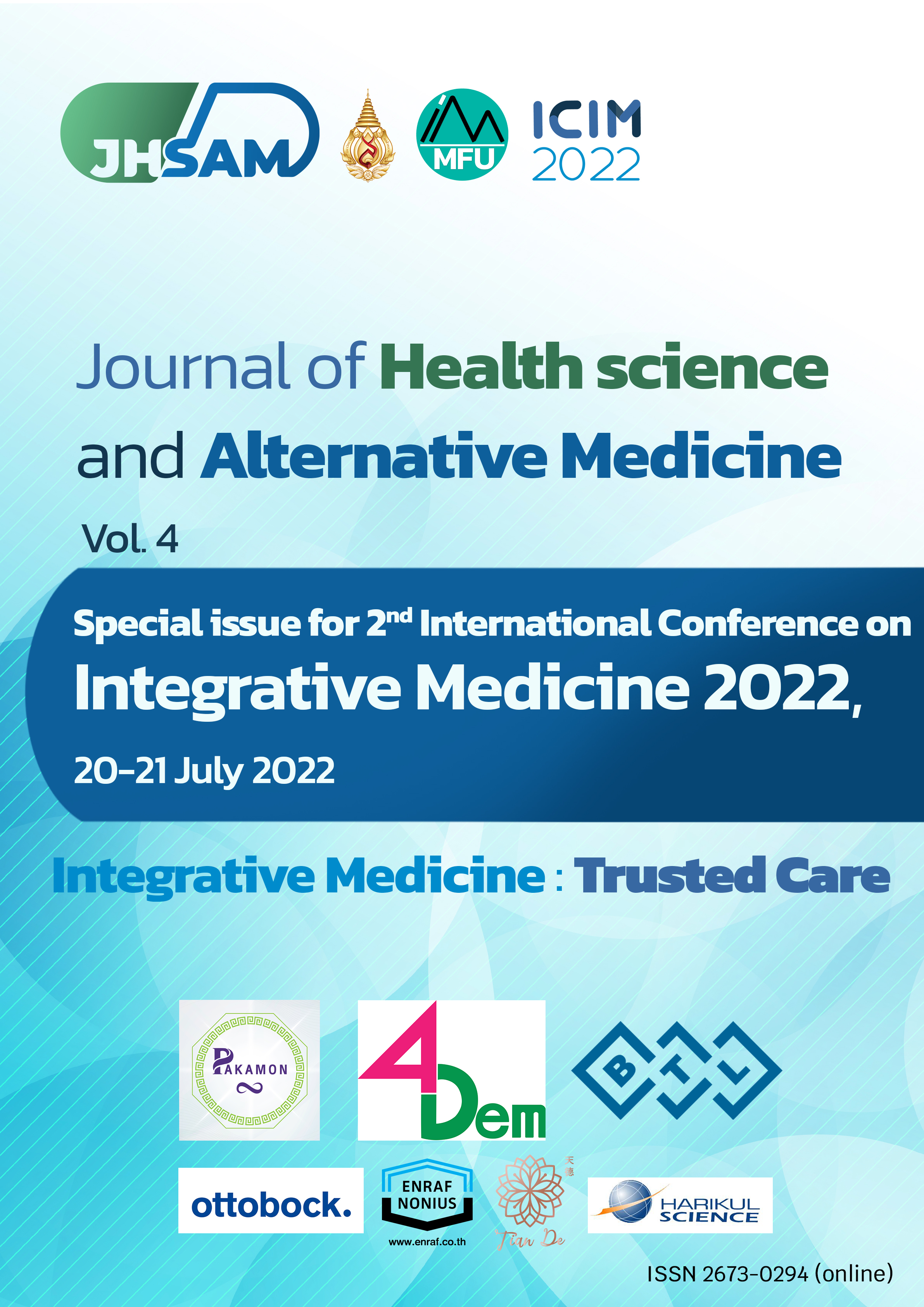C15. Content Validity of Thai Version Screening Tool for Cervical Spine Instability
Main Article Content
Abstract
Introduction: Cervical spine instability is a disorder in which the cervical spine cannot maintain its normal alignment under physiological loads to protect the blood vessels, nerves, and spinal cord from damage or irritation. The symptoms of cervical spine instability present include neck pain, dizziness, inability to prolong holding the head, and impaired movement. The more severe symptoms can cause cervical spondylolisthesis. Therefore, it is necessary to have an early screening tool for cervical spine instability to avoid complications and consequences. However, this screening tool is limited in its use by language for the Thai therapist who is a non-English speaker.
Objective: The primary objective of this study was to translate the 16 items of the cervical spine instability screening tool from English to the Thai language. The secondary objective was to test the content validity of the cervical spine instability screening tool Thai version.
Methods: The cervical spine instability screening tool was translated from the original English language into the Thai language by the process of cross-cultural adaptation. Then, the content validity was tested by using the index of Item-Objective Congruence (IOC) which was obtained by a group of expert. 5 independent experts with clinical experience more than 5 years in treating neck pain patients including 3 physiotherapists and 2 orthopedic surgeons.
Results: The IOC index rating by 5 independent experts reached an average of 0.90 (range 0.60-1.00).
Conclusion: The screening tool (Thai version) for patients with cervical instability has satisfactory content validity (average IOC = 0.90) for application in clinical practice.
Article Details

This work is licensed under a Creative Commons Attribution-NonCommercial-NoDerivatives 4.0 International License.
JHSAM publishes all articles in full open access, meaning unlimited use and reuse of articles with appropriate credit to the authors.
All our articles are published under a Creative Commons "CC-BY-NC-ND 4.0". License which permits use, distribution and reproduction in any medium,
provided that the original work is properly cited and is used for noncommercial purposes.
References
Webb R, Brammah T, Lunt M, Urwin M, Allison T, Symmons D. Prevalence and predictors of intense, chronic, and disabling neck and back pain in the UK general population. Spine. 2003 Jun 1;28(11):1195-202.
Fejer R, Kyvik KO, Hartvigsen J. The prevalence of neck pain in the world population: a systematic critical review of the literature. European spine journal. 2006 Jun;15(6):834-48.
Ferrari R, Russell AS. Regional musculoskeletal conditions: neck pain. Best Practice & Research in Clinical Rheumatology 2003;17:57e70.
Hush JM, Michaleff Z, Maher CG, Refshauge K. Individual, physical and psychological risk factors for neck pain in Australian office workers: a 1-year longitudinal study. European spine journal. 2009 Oct;18(10):1532-40.
Dai L. Disc degeneration and cervical instability: correlation of magnetic resonance imaging with radiography. Spine. 1998 Aug 15;23(16):1734-8.
Dupuis PR, Yong-Hing K, Cassidy JD, Kirkaldy-Willis WH. Radiologic diagnosis of degenerative lumbar spinal instability. Spine. 1985 Apr 1;10(3):262-76.
Panjabi MM. The stabilizing system of the spine. Part II. Neutral zone and instability hypothesis. Journal of spinal disorders. 1992 Dec 1;5:390.
Steilen D, Hauser R, Woldin B, Sawyer S. Chronic neck pain: making the connection between capsular ligament laxity and cervical instability. The open orthopaedics journal. 2014;8:326.
Cook C, Brismée JM, Fleming R, Sizer Jr PS. Identifiers suggestive of clinical cervical spine instability: a Delphi study of physical therapists. Physical Therapy. 2005 Sep 1;85(9):895-906.
Alizada M, Li RR, Hayatullah G. Cervical instability in cervical spondylosis patients. Der Orthopäde. 2018 Dec;47(12):977-85.
Centeno CJ, Elkins W, Freeman M, Elliott J, Sterling M, Katz E. Total cervical translation as a function of impact vector as measured by flexion-extension radiography. Pain Physician. 2007;10(5):667.
Cramer H, Lauche R, Langhorst J, Dobos GJ, Michalsen A. Validation of the German version of the Neck Disability Index (NDI). BMC musculoskeletal disorders. 2014 Dec;15(1):1-7.
Lim HH, Tang ZY, Hashim MA, Yang M, Koh EY, Koh KH. Cross-cultural adaptation, reliability, validity, and responsiveness of the Simplified-Chinese Version of Neck Disability Index. Spine. 2020 Apr 15;45(8):541.
Uthaikhup S, Paungmali A, Pirunsan U. Validation of Thai versions of the Neck Disability Index and Neck Pain and Disability Scale in patients with neck pain. Spine. 2011 Oct 1;36(21):E1415-21.
Beaton DE, Bombardier C, Guillemin F, Ferraz MB. Guidelines for the process of cross-cultural adaptation of self-report measures. Spine. 2000 Dec 15;25(24):3186-91.

